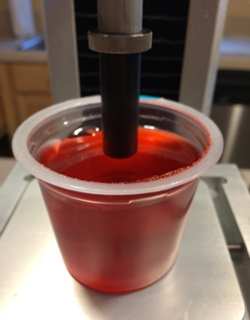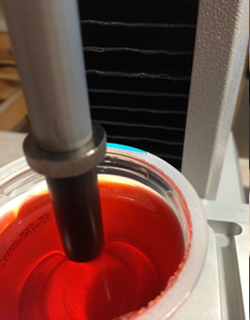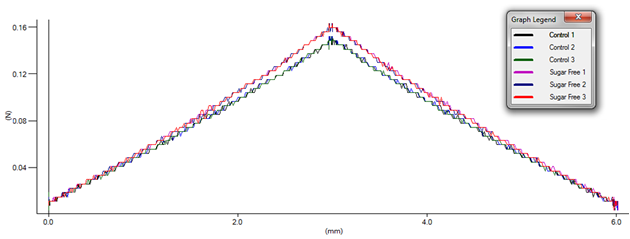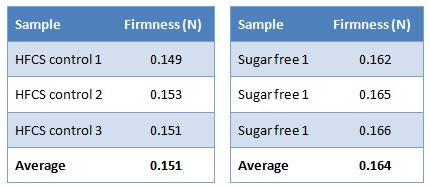Texture Analysis SolutionsGelatin Snacks Regular and Sugar-Free
Highlights
- Objective comparative measurement based on the Industry-standard test to measure the firmness of a gel snack with different sugar content
- Repeatable procedural method using a software-controlled texture analyzer to perform the steps
- Industry-standard cylinder probe to compress the surface and compare formulation alternatives
- Measured hardness texture correlated to mouthfeel for regular and low-sugar varieties of product
Situation
 Sweeteners are under the spotlight in many foods, and choice of sweetener affects both taste and mouthfeel. To ensure a reformulation of an established product continues to meet consumer expectations, objective data are required. This may be very difficult as regards taste, but for mouthfeel, a food texture analyzer provides a reliable answer. In this example, we compare a gelatin snack formulated with HFCS (high fructose corn syrup), with the same product formulated with aspartame.
Sweeteners are under the spotlight in many foods, and choice of sweetener affects both taste and mouthfeel. To ensure a reformulation of an established product continues to meet consumer expectations, objective data are required. This may be very difficult as regards taste, but for mouthfeel, a food texture analyzer provides a reliable answer. In this example, we compare a gelatin snack formulated with HFCS (high fructose corn syrup), with the same product formulated with aspartame.
Method
 The method is loosely based on the Bloom test for measuring the strength of a gel or gelatin, but instead of applying weight to a probe, a downwards machine movement is applied and the force data gathered continuously. In this example, a Food Technology Corporation (FTC) TMS-Pro Texture Analyzer was used, fitted with a 25 N intelligent loadcell, and a 12.7mm (1/2 inch) diameter Bloom cylinder probe.
The method is loosely based on the Bloom test for measuring the strength of a gel or gelatin, but instead of applying weight to a probe, a downwards machine movement is applied and the force data gathered continuously. In this example, a Food Technology Corporation (FTC) TMS-Pro Texture Analyzer was used, fitted with a 25 N intelligent loadcell, and a 12.7mm (1/2 inch) diameter Bloom cylinder probe.
All the samples were allowed to equilibrate under refrigeration to a temperature of 40°F. Each sample cup was removed in turn from the refrigerator and immediately tested. The test program moved the probe to detect touching the surface of the sample, and then move down a further 3 mm before returning to the start position. The peak force achieved is a measure of the firmness of the gel.
Three HFCS-sweetened samples were tested against three containing aspartame.
Results
The graphical representation from TL-Pro, of the test results for the four samples, is shown here (force applied, against cumulative displacement).

At maximum displacement, the two sample types are distinguishable. What is noticeable is how repeatable the test is. By selecting a probe, speed, and displacement for best comparison of a given product, greater separation by firmness can be achieved. A smoother curve will be obtained by using a loadcell of finer resolution.
The same results with additional calculations are shown here.

- Average = arithmetic mean
Significance
The difference in firmness of these samples may not be distinguishable by subjective mouthfeel testing, but they do show a change to a softer product when sugar-free. Other formulations can be compared accurately by using a texture analyzer. It is also possible to test to a point of rupture in the gel, and measure the texture around this point. The Bloom test was developed for gel strength, but a gelatin snack also needs to feel good as it is broken down in the mouth.
